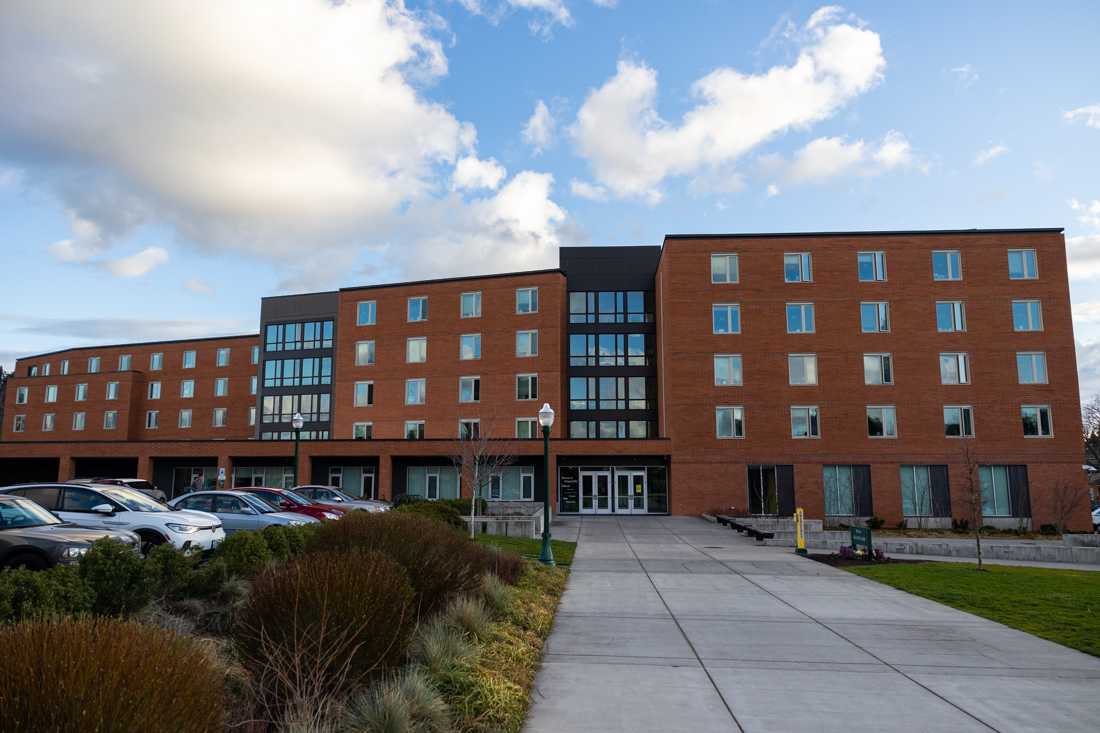Steve Mital, director of the University of Oregon’s office of sustainability, stood in front of a podium and acknowledged that most people were there for one thing: the goats.
Behind him, two goats named Bert and Ernie dispassionately nibbled on the blackberry bushes that fortify the Willamette river’s bank.
“This is a great day to celebrate,” Mital said to the crowd.
UO brought out 10 goats to graze along the Willamette Natural Area and invited four speakers to praise Campus Planning and Facility Management’s new proposed plan on May 24.
“This is a new opportunity for us to think through how we could steward this area,” Mital said.
UO has property that reaches the banks of the Willamette River. According to Jeff Krueger, UO acquired the riverbank property called the Willamette Natural Area in 1970. Krueger, a UO instructor in the School of Architecture and Environment, was a speaker at the event. In 2018, UO received a permit designating the area as designated for future habitat restoration, Krueger said.
“It’s a very achievable thing to do, habitat restoration,” Krueger said.
Efforts to carry out this restoration in the plan include enhancing grasslands to increase native grass diversity, expanding mixed woodland and controlling invasive species to supplement native vegetation in their place.
The Society for Ecological Restoration at UO helped facilitate the planning and preparation for the goat grazing. After the goats leave, UO graduate students and SER members Cal Penkauskas and Sarah Erskine said a grazing program could potentially be a part of the management plan.
Ideally, a herd of fenced-off, free-ranging goats would graze all week to push back the thick blackberry bushes at least twice a year, allowing native species to grow in its space and opening up the riverfront for easier access, Penkauskas said.
Reintroducing disturbances like goats and people will benefit the area, he said. Before colonization, indigenous peoples managed the area through burning and other culturally significant treatments, he said.
“Without that disturbance, certain plants will then dominate the landscape,” he said. “But because there’s nothing to push them back, the native species that evolved with that disturbance regime can’t compete anymore.”
Krueger said the plan would incorporate more culturally-significant plants to indigenous peoples, such as camas, tarweeds, elderberry, dogweed and hazel.
“It’s really important for us to acknowledge that Native Americans lived in the Willamette Valley for thousands of years,” Krueger said.
The plan would also include the creation of a soft-surface universal access trail, an osprey nesting platform, native habitat art display, easier ways for people to access to the riverfront and areas to be used as outdoor classroom spaces or field studies.
“One of the issues we’ve identified is there’s really no safe way to get to the river,” Krueger said. He occasionally brings his students to study the river but has trouble reaching the water’s edge, he said.
Adell Amos, a UO professor and the executive director for the environment initiative at the UO, said it can be easy to be cynical about institutions but that UO is trying to be an antidote.
“The possibility that we could have an outdoor classroom in this spot is really exciting to me,” she said.
No firm date has been set for a decision on the proposed plan’s approval.
Although the goats are helping with habitat restoration, the project is really focused on restoring relationships — especially between students and their campus, Penkauskas said. He hopes students will use the space for research or just to sit and enjoy the area.
“In modern culture, American culture, we think of nature being other, somewhere else and out there,” he said. “The reality is that it is right here, and we have to cultivate that relationship with the land again.”
Ernie, one of the goats helping clear blackberries from the Willamatte Riverfront, walks across the grass near the Willamatte River. The University of Oregon is creating a new plan to improve the area surrounding the Willamatte Riverfront, making it more accessable to foot traffic and removing invasive species. (Will Geschke/Emerald)









